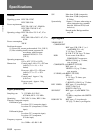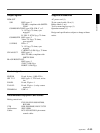
Appendixes
Appendixes A-67
Key clip
In luminance keys, to specify a
reference luminance level. The
part of the signal above the
reference level is used as the key
source signal. See also “key
source”.
Key fill
A signal used to fill the hole cut
with the key source signal.
Key frame
User program effect data which
defines the effect at a specific
point. User program effects are
made up of sequentially executed
key frames.
Key gain
The sensitivity of circuits, which
can be adjusted with the switcher’s
key gain control. This is done to
obtain the desired blurring of key
edges.
Key invert
In luminance key, to reverse the
polarity of a key source signal so
that the hole is cut with the darker
part of the signal.
Key mask
To hide part of a title key or
downstream key signal so that only
the desired part is used.
Key source
A signal used to cut a hole in a
background picture for insertion of
a key fill signal.
Luminance key
Key effect in which a luminance
signal is used to define the outlines
of characters or graphics.
Luminance signal
The part of a video signal that
carries brightness information.
Also called the Y signal.
Mix
Effect in which one signal fades in
while another fades out. Also
called dissolve.
Pre-read editing
A/B roll editing using the output
(playback) of the recorder VTR
and a player VTR.
Preroll
Running a videotape a certain
distance before the edit IN point in
order to bring the tape to a steady
speed and synchronize it with
other tapes.
Postroll
Running a videotape a certain
distance past the edit OUT point in
order to monitor the video that
follows.
R–Y signal
A color difference signal. The red
signal minus the Y signal.
RGB signal
A signal format in which red,
green, and blue signals are
transmitted separately. A separate
sync signal may be sent, or the
sync signal can be added to the
green signal. The DFS-700/700P
uses the latter method.
Saturation
The extent to which a color has
been diluted by white. Pure red is
fully saturated, while pink is
diluted.
SDI
A serial component digital signal.
S-video signal
A video signal with separate
luminance (Y) and chrominance
(C) components. As opposed to
composite video, S-video provides
higher quality by eliminating
interference between the Y and C
signals.
Snapshot
Data containing the settings of
specific controls on the control
panel. Snapshots can be saved and
recalled to restore the control panel
to a desired state.
Subcarrier (SC)
The part of a video signal that
carries color information. The
amplitude represents saturation,
and the relative phase against the
color burst signal represents hue.
Also called the color subcarrier.
Title key
Effect used to superimpose
foreground characters or graphics
on a background. Requires a key
source signal to define the outlines
of the characters or graphics, and a
key fill signal to fill the outlines.
See also “downstream key”.
Transition
A period during which one picture
is replaced by another, or a period
during which a key is inserted or
deleted.
Wipe
A transition effect in which one
picture moves in to replace
another. Often the new picture
appears as a geometrical shape
such as a circle or star.
YUV signal
An analog component signal,
consisting of a luminance (Y)
signal, a color difference signal U
(B–Y) and a color difference signal
V (R–Y).


















